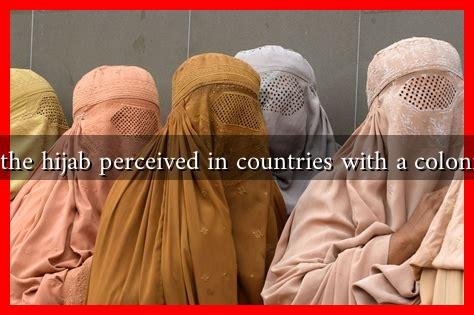-
Table of Contents
How is the Hijab Perceived in Countries with a Colonial Past?
The hijab, a traditional headscarf worn by many Muslim women, has become a symbol of both faith and identity. However, its perception varies significantly across different cultures, particularly in countries with a colonial past. This article explores how historical colonialism has shaped contemporary views on the hijab, examining the complexities of identity, religion, and cultural heritage.
The Colonial Legacy and Its Impact on Identity
Colonialism has left deep scars on the cultural and social fabric of many nations. In countries where colonial powers imposed their values and norms, the hijab often became a focal point of resistance and identity. The perception of the hijab in these contexts can be understood through several lenses:
- Resistance to Colonialism: For many women, wearing the hijab symbolizes a rejection of colonial imposition. It serves as a reminder of their cultural heritage and a way to assert their identity in the face of Westernization.
- Western Stereotypes: In post-colonial societies, the hijab is often viewed through the lens of Western stereotypes that associate it with oppression. This perception can lead to internalized stigma among women who choose to wear it.
- Gender Politics: The hijab has become a battleground for discussions about women’s rights and autonomy. In some cases, it is seen as a tool of empowerment, while in others, it is viewed as a symbol of patriarchal control.
Case Studies: The Hijab in Different Contexts
To better understand the perception of the hijab in post-colonial societies, we can examine specific case studies from various countries.
1. Algeria
In Algeria, the hijab is deeply intertwined with the country’s colonial history. During French colonization, the hijab was often banned as part of a broader effort to secularize and Westernize Algerian society. After gaining independence in 1962, the hijab re-emerged as a symbol of national identity and resistance. Today, while some women wear it as a personal choice, others view it as a political statement against Western influence.
2. Indonesia
Indonesia, the largest Muslim-majority country, has a complex relationship with the hijab. Under Dutch colonial rule, Islamic practices were often suppressed. However, post-independence, the hijab has gained popularity as a symbol of Islamic identity. Recent statistics indicate that approximately 70% of Indonesian Muslim women wear the hijab, reflecting a blend of personal choice and cultural revival.
3. India
In India, the hijab is often perceived through the prism of communal tensions and identity politics. The colonial legacy has contributed to a complex relationship between Muslims and the state. The hijab can be seen as both a marker of religious identity and a point of contention in debates about secularism and women’s rights. Recent controversies surrounding hijab bans in educational institutions have sparked nationwide protests, highlighting the ongoing struggle for religious freedom.
Global Perspectives and the Role of Media
The global media plays a significant role in shaping perceptions of the hijab. Often, Western media portrayals focus on the hijab as a symbol of oppression, neglecting the voices of women who choose to wear it. This can lead to a skewed understanding of the hijab’s significance in various cultures. Social media platforms have emerged as spaces for women to share their experiences and challenge stereotypes, fostering a more nuanced dialogue about the hijab.
Conclusion: A Complex Symbol of Identity
The perception of the hijab in countries with a colonial past is multifaceted, shaped by historical legacies, cultural identity, and contemporary gender politics. While it can symbolize oppression in some contexts, for many women, it represents empowerment and a connection to their heritage. Understanding these complexities is crucial for fostering respectful dialogue and challenging stereotypes surrounding the hijab.
As societies continue to grapple with issues of identity and belonging, the hijab will remain a significant symbol, reflecting the ongoing interplay between tradition and modernity. For further reading on this topic, you can explore resources from organizations like Human Rights Watch that delve into women’s rights and cultural identity.

